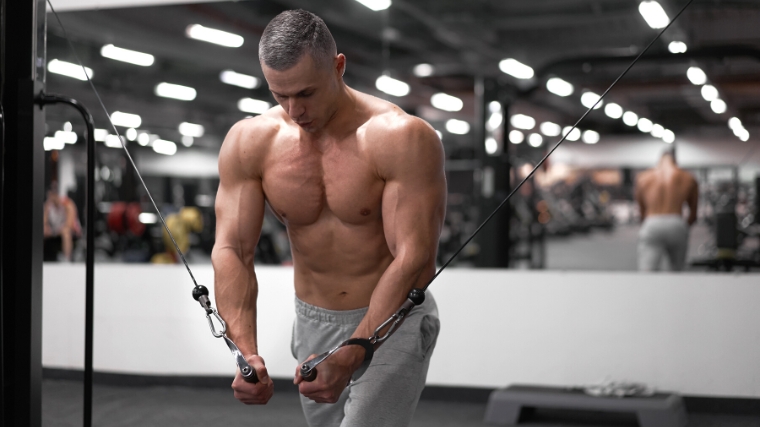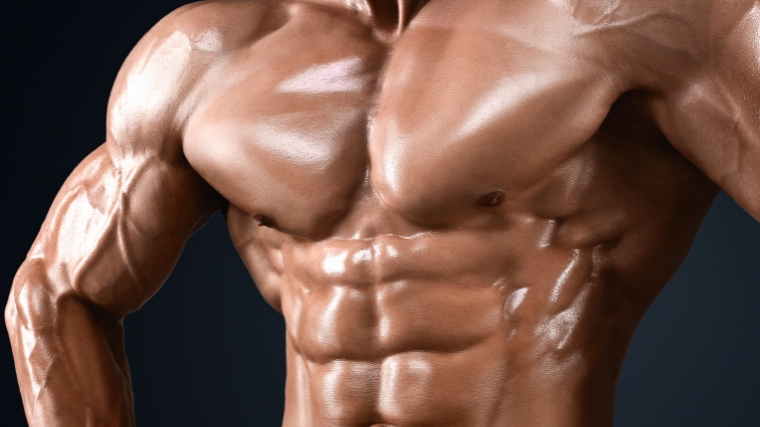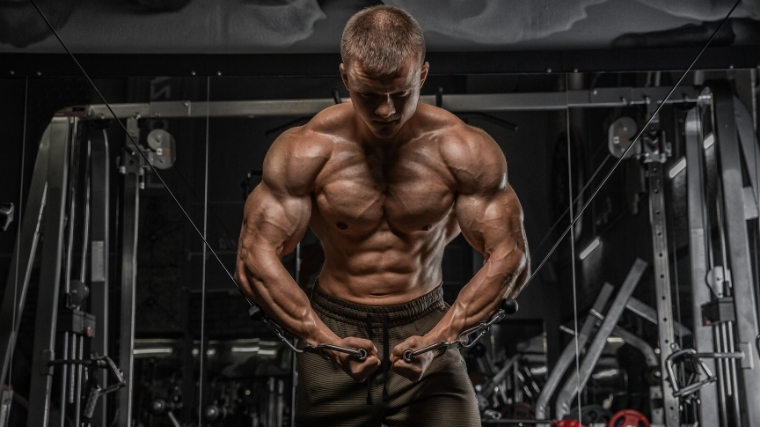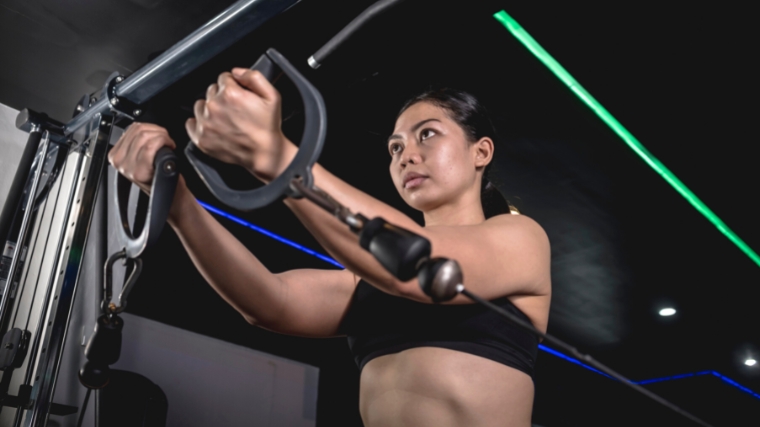Inner chest, outer chest, lower chest, upper chest … chest. Regular gymgoers, full-time bodybuilders and, heck, even strength athletes of all stripes want a broad, powerful, three-dimensional pair of pecs.
If you want to build the best version of your chest, you need to look beyond the bench press. Contrary to what you might hear around the water fountain at your local gym, you can train your inner chest to a meaningful degree.

Doing so will require creativity, ingenuity, and a thorough understanding of your own anatomy. Oh, and you’ll have to work hard, too. These are five of the best exercises you can perform to blast your inner chest, plus how to weave them into your next pec workout.
Best Inner Chest Exercises
- Deficit Weighted Push-Up
- High-to-Low Cable Flye
- Single-Arm Cable Press-Around
- Incline Hex Press
- Dumbbell Bench Press
Deficit Weighted Push-Up
Range of motion is the name of the game when it comes to comprehensive chest development. To guarantee that you’re not leaving a single chest fiber untouched, you should strive to work your pecs through as large a range of motion as you can comfortably go.
The humble push-up may be too easy to induce real muscular hypertrophy. However, slap a plate on your lower back and place some blocks under your hands, and you’ve got a different beast entirely, especially for your inner pecs.
Benefits of the Deficit Weighted Push-Up
- Takes your chest through a full range of motion under load.
- A great way to finish your workout.
- Has a relatively simple technique, making it easy to learn.
How to Do the Deficit Weighted Push-Up
Get a pair of foam blocks or floor handles to elevate your hands. Then, assume a standard push-up position. Your best bet for external resistance is to have a friend place a weight plate on your upper back.
Once you’re set up, descend into a push-up by bending at the elbows and lowering your chest down to the floor. Descend until your chest touches the ground and you experience a deep stretch across your chest, and then forcefully press back up.
High-to-Low Cable Flye
Any chest workout worth its salt has at least one cable exercise included. When it comes to ensuring you’re hitting your inner chest properly, the high-to-low cable flye is second-to-none.
Not only will you find that the exercise attacks your pecs overall, but pulling from a high attachment should make it quite intuitive to really squeeze your inner pecs at the end of each repetition.
Benefits of the High-to-Low Cable Flye
- Provides constant tension to your pecs.
- Cables make it easy to “feel” your inner chest working.
- Simple to perform and allows you to adjust resistance quickly.
How to Do the High-to-Low Cable Flye
Set a dual cable station such that the handles are at or above shoulder height. Grab each handle and step away from the station until the plates come off the stack. Then, with unlocked but mostly-straight elbows, draw your arms across your body until your hands come together.
Hold for a beat at the end and really squeeze your pecs before slowly reversing the motion. Allow the cables to pull your arms open slowly.
Single-Arm Cable Press-Around
If you’re trying to develop a specific region of a specific muscle, you should probably include equally specialized exercises. This one is a real treat, and you’ve probably never performed it before.
The single-arm cable press-around mixes extended ranges of motion with constant tension from a cable tree to deliver an unparalleled level of mechanical tension to your pecs. It should be more than enough to get your inner chest in the game.
Benefits of the Single-Arm Cable Press-Around
- Puts a unique twist on chest training that you can’t get from many other movements.
- Applies consistent tension to your pecs through their full contractile range.
- Lets you work unilaterally to address any imbalances.
How to Do the Single-Arm Cable Press-Around
Set a cable fixture around waist height and grab the handle with your working arm. Turn away from the handle such that your arm is being pulled out and behind you. Then, press the handle out and across your torso.
Make a deliberate effort to cross your midline with the cable. You may bend your elbow as much as needed, but focus hard on pushing your upper arm “into” your chest.
Incline Hex Press
No, this movement won’t put a spell on you — the hex press gets its name from the fact that, ideally, you’d perform this movement with a pair of hexagonally-sided dumbbells. This allows you to push them against one another throughout each repetition, adding extra isometric tension to your pecs.
You can use traditional circular-plated dumbbells and do just fine. Hop on an incline bench and you’ll see that this movement absolutely demolishes your inner pecs.
Benefits of the Incline Hex Press
- Enables you to hit your upper chest and inner chest simultaneously.
- Provides extra tension to your shoulders and triceps.
- Convenient to perform since you only need dumbbells and a bench.
How to Do the Incline Hex Press
Set an adjustable bench such that the back pad is between 30 and 45 degrees relative to the floor. Grab a pair of dumbbells and sit on the bench. Press the dumbbells up over your head and then set them together at the top.
Then, lower them down slowly until they touch your chest before pressing aggressively back up. The dumbbells should be in contact with each other the whole way. Squeeze your pecs together to ensure they stay in contact.
Dumbbell Bench Press
Any good chest-building program — whether you need to bring up a lagging area or not — should begin with a solid foundation. That foundation, generally speaking, will be a loadable pressing movement.
The barbell has earned its stripes in the weight room and then some, but if you want to make every last fiber in your chest (including and especially your inner chest fibers) work as hard as they can, you should probably head to the dumbbell rack instead.
Benefits of the Dumbbell Bench Press
- Provides carryover strength to other chest exercises.
- Easier to learn than the barbell variation.
- Allows you to work each of your arms independently.
How to Do the Dumbbell Bench Press
Get ahold of a flat bench and a pair of moderate-to-heavy dumbbells. Sit down on the edge of the bench with a dumbbell resting on each knee. In one fluid motion, kick off the floor and sit back with the dumbbells — use your knees to guide them into position above your shoulders.
Once you’re set up, slowly bend your elbows and lower the weights down and out as far as you can comfortably go. Ideally, you should descend until your upper arm is at least parallel to the floor. Reverse the motion and push the weights up and in at the same time.
Anatomy of the Chest
If you want a pair of pecs that turn heads, the last thing you should do is take shots in the dark. Haphazardly sticking exercises into your workout plan without knowing the “why” is a recipe for suboptimal results.
This is especially important if you’re trying to bring up your inner chest. There’s nuance to addressing weak points in bodybuilding; your first step should be to understand your own chest anatomy.
The “Inner Chest”
The musculature of your chest is divided into two distinct tissues; the small, unseen-by-the-naked-eye pectoralis minor, and the more prominent pec major. The pec major has two heads; sternocostal and clavicular. Both attach to your humerus, despite originating from different points.
Anatomically, there’s no distinct “inner chest” compartment in your pecs. Your inner chest is more of a visual descriptor, rather than a separate muscle that you can train in isolation. When bodybuilders talk about training their inner chests, what they’re really discussing is regional hypertrophy — working a specific part of a specific muscle.

Is regional hypertrophy possible? The existing scientific literature isn’t so sure, but there’s some compelling evidence. Some data has shown that changing your foot angle when using the leg extension machine can create more muscular engagement in certain parts of your quadriceps. (1)
More specific studies on exercises like the bench press reveal similar findings. Changing the angle from which you perform a bench press affects which areas of the pecs “light up” during electromyographical (EMG) analysis. (2) In simple terms, there’s some credibility to inner-chest-biased training, but there isn’t published evidence directly supporting it in a clinical setting.
Inner Chest Training Tips
To get the most out of your chest workouts and build up your inner pecs, stick to these guiding principles. This isn’t a list of must-do movements or hard rules; think of these tips as the overarching framework for proper training.
Find Your Line (of Pull)
As a bodybuilder, one of the best things you can do on each and every exercise, within reason, is to customize your setup or execution. Adjusting how you perform, say, a cable flye, such that the line of pull matches the orientation of your chest fibers, can make all the difference.

[Read More: Best Upper Chest Exercises for Building Muscle]
Most of the fibers in your pecs run horizontally, so your arm should move along a similar path. Altering your line of pull should create a tangible difference in how an exercise feels. Take the time to make sure you “find” your inner chest on each exercise you perform.
Feel It, Seriously
Training by feel isn’t always wise. When it comes to programming, you should follow some type of periodization or plan. However, in bodybuilding, feeling the working muscle is crucial, particularly during isolation exercises.
This isn’t superstition, it’s science. Some literature has discussed the implications of the mind-muscle connection, suggesting that actively focusing on the area in question (in this case, your inner chest) may be a viable strategy for increasing hypertrophy. (3)
Use Isolation Movements
Large compound exercises that work several muscles simultaneously should be the backbone of your workout routine. That said, you can’t carve out the finer details of your physique if you only work with a sledgehammer. Sometimes you need a scalpel; targeted isolation exercises.
For your inner chest, you should rely heavily on single-joint movements like flyes. These smaller exercises limit the amount of weight you can use but are challenging all the same. They’re also generally easy to stabilize and don’t tax your cardiovascular system very much, so you can devote all of your attention to squeezing your inner chest.
Exercise Patience
It’s applicable to nearly all fitness goals, but it bears repeating — growing muscle takes time. This is doubly true if you’re trying to make a noticeable change to a muscle you’ve already worked hard on for several years.

When your weight room career is in its infancy, your muscles grow like weeds. You often see visible changes in the mirror on a month-to-month basis. If you have a few years of training under your belt, get comfortable with the process. You can definitely build up your inner chest, just know that it won’t happen overnight.
Three-Dimensional Chest Gains
There’s no shame in wanting a chest to be proud of. The bench press will take you far, but elevating your pec game to the next level will probably take a finer touch. To build up your inner chest, you need the right exercises. Luckily, now you have them at your disposal. The rest is up to you.
References
- Stoutenberg, M., Pluchino, A. P., Ma, F., Hoctor, J. E., & Signorile, J. F. (2005). The impact of foot position on electromyographical activity of the superficial quadriceps muscles during leg extension. Journal of strength and conditioning research, 19(4), 931–938.
- Glass, Stephen C.; Armstrong, Ty. Electromyographical Activity of the Pectoralis Muscle During Incline and Decline Bench Presses. Journal of Strength and Conditioning Research 11(3):p 163-167, August 1997.
- Schoenfeld, B. J., Vigotsky, A., Contreras, B., Golden, S., Alto, A., Larson, R., Winkelman, N., & Paoli, A. (2018). Differential effects of attentional focus strategies during long-term resistance training. European journal of sport science, 18(5), 705–712.
Featured Image: andreonegin / Shutterstock